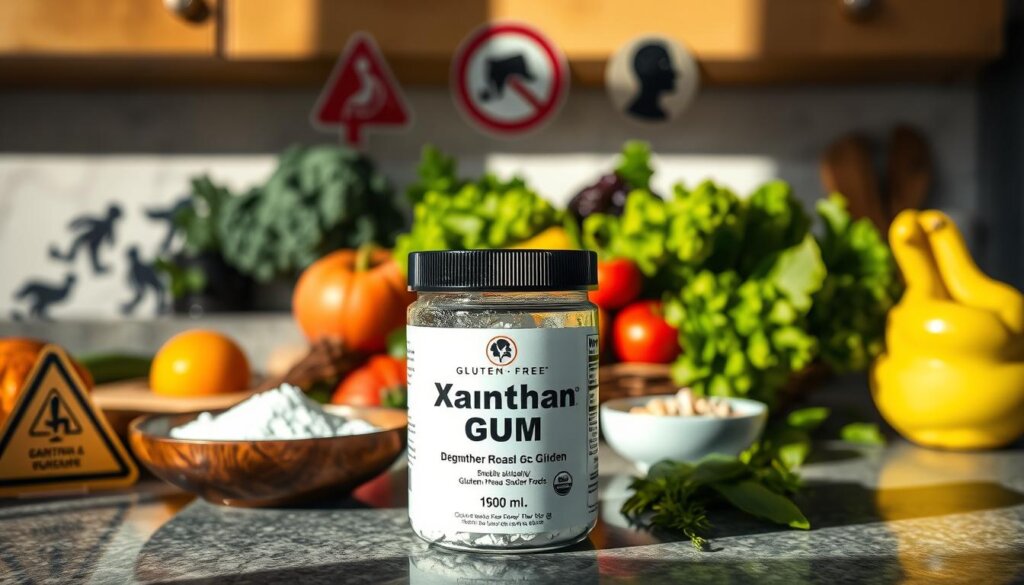Ever thought about xanthan gum and its role in gluten-free baking? This popular thickener mimics gluten by improving texture and stability in foods like baked goods and dressings. But is it safe for everyone, especially those with sensitive stomachs?
For more gluten-free tips, check out Best Gluten-Free Flour Alternatives and learn about Chickpea Flour as a Natural Binder. If you’re exploring substitutes, don’t miss our guide to Easy Gluten-Free Grain-Free Wraps for a tasty and safe option.
Table of contents
What is Xanthan Gum?
Xanthan gum is a food additive used to thicken, stabilize, and emulsify. It’s mainly used in cooking and baking. It helps improve texture and consistency in many products.
Production Process
To make xanthan gum, sugars like sucrose and glucose are fermented with Xanthomonas campestris. This makes a thick liquid. It’s then purified, dried, and ground into a powder.
This powder dissolves well in liquids. It’s why xanthan gum is so popular in cooking and baking.
Common Uses in Food
Xanthan gum is used in many foods, like sauces and gluten-free baked goods. It thickens well without changing flavors. For gluten-free baking, use about 1/4 teaspoon of xanthan gum per cup of flour.
This helps the dough stay elastic and bind well. Xanthan gum also helps gluten-free breads and pizzas rise.
| Application | Recommended Amount |
|---|---|
| Baking (gluten-free) | 1/4 teaspoon per cup of flour |
| General thickening (sauces, soups) | Up to 1 tablespoon |
| Binders for gluten-free goods | 1 tablespoon or less |
In summary, xanthan gum is key in many food products. It’s vital for both food manufacturers and home bakers.

Common Applications of Xanthan Gum
Xanthan gum is used in many ways, in food and non-food products. It makes things better by changing texture and keeping things stable. Knowing how it works in baking and other areas helps us use it well.
Baking and Gluten-Free Products
In gluten-free baking, xanthan gum is key. It keeps gluten-free flour moist and gives it structure, like gluten does. Many gluten-free mixes already have xanthan gum for the best texture.
The right amount is important. Cakes need more than biscuits. It makes gluten-free baked goods soft and together, like the real thing.

- Improved moisture retention
- Enhanced structural support
- Better elasticity
- Consistency in foaming stability across different baked goods
If you don’t want xanthan gum, you can use chia or flax eggs, tapioca starch, or arrowroot. They can also make baking work well.
Non-Food Uses
Xanthan gum is not just for food. It’s in cosmetics like creams and lotions, making them smooth. It also helps in many industrial uses.
| Application | Description |
|---|---|
| Thickening Agent | Used in sauces and dressings to get the right thickness. |
| Stabilizer | Keeps emulsified products together, so they’re even. |
| Industrial Use | In drilling fluids and paints, it adds stability and texture. |
Xanthan gum is important in food, cosmetics, and industry. It shows how useful it is in many areas, making it a key ingredient today.
Is Xanthan Gum Gluten Free?
Xanthan gum’s gluten-free status is a bit tricky. It’s often used in gluten-free baking. It’s also a thickener, binder, and emulsifier. But, its origin can be a worry.
Xanthan gum comes from fermentation. This process can use corn, wheat, soy, and dairy. This makes it a concern for those with gluten sensitivity.
Many gluten-free xanthan gum brands are safe. They remove gluten during purification. But, those allergic to corn or soy should be careful.
It’s important to pick xanthan gum from reliable makers. They focus on food safety.
If gluten sensitivity or allergies are a concern, look into other options. Guar gum and psyllium husk are good substitutes. They work well in many recipes.
When baking, use 1/4 to 2 teaspoons of these substitutes per cup of flour. This helps in making cookies, cakes, and breads.
The Potential Health Risks Associated with Xanthan Gum
Xanthan gum is a food additive that the FDA says is safe. But, some people might face health risks. It’s key to know about side effects and allergic reactions from eating it.
Digestive Issues
Some folks get upset stomachs from xanthan gum in foods. They might feel:
- Bloating
- Gas
- Diarrhea
Too much xanthan gum can make you feel like you need to go to the bathroom a lot. It can change the good bacteria in your gut. It’s smart to watch how much you eat and how you react to it.
Allergies and Sensitivities
Allergic reactions to xanthan gum are rare but can happen. This is more likely if you’re allergic to corn or soy, which are used in making xanthan gum. Signs include skin problems or stomach pain. If you have a severe allergy or health issue, talk to a doctor before eating foods with xanthan gum.

For more on xanthan gum’s effects and safety, check out this in-depth article. Knowing how xanthan gum affects you can help you choose better foods.
Healthier Alternatives to Xanthan Gum
If you’re looking for xanthan gum alternatives, several healthy ingredients can serve as effective substitutes in baking and cooking. These options not only maintain the desired texture but also contribute to a healthier diet. Consider experimenting with these alternatives for a better overall culinary experience.
Substitutes for Baking
When it comes to xanthan gum substitutes, several ingredients can work well in gluten-free recipes:
- Psyllium Husk Powder: This works excellently as a binding agent and should be used in a ratio of 2 parts for every 1 part of xanthan gum.
- Chia Seeds: When ground and mixed with hot water, chia seeds can replace xanthan gum in a 1:1 ratio, adding moisture and structure.
- Ground Flax Seeds: Similar to chia, flax seeds can be combined with hot water in a 1:1 ratio to deliver fluffy baked goods.
- Cornstarch: A great all-purpose alternative, it can substitute xanthan gum in a 1:1 ratio without requiring water beforehand.
- Agar Agar: This plant-based alternative offers binding and thickening capabilities, also in a 1:1 ratio.
Natural Ingredients for a Healthier Diet
Using healthy ingredients in your cooking can elevate your dishes while avoiding additives. For instance, you might incorporate:
- Egg Whites: An excellent binding substitute; replace one tablespoon of xanthan gum with one egg white.
- Unflavored Gelatin: This can be effective in a ratio of 2:1 compared to xanthan gum, adding moisture and a delightful texture.
- Konjac Powder: Use it in a 1:1 ratio or increase it slightly for chewier textures.
These xanthan gum alternatives not only enhance your baking but also align with a framework of healthy ingredients. Utilizing these substitutes will lead to nutritious, satisfying meals without compromising on taste. For a more detailed guide on gluten-free baking, check out this article.
Conclusion
Xanthan gum is key in gluten-free baking. It makes products better by changing their texture and feel. It’s made from sugar and a special bacterium, Xanthomonas campestris.
This ingredient thickens, binds, and mixes well, like gluten. But, it might come from corn or soy. This is a problem for people with certain food allergies.
Xanthan gum is used a lot in gluten-free foods. But, it’s important to know its good and bad sides. Some people might feel sick after eating it, while others might see their cholesterol go down.
Choosing what you eat is all about knowing what’s in your food. With the right info, you can pick the best gluten-free options. This way, you meet your dietary needs and likes.
FAQ
What is xanthan gum and how is it used in gluten-free baking?
Xanthan gum is a food additive. It thickens, stabilizes, and emulsifies. In gluten-free baking, it helps with texture and moisture.
Is xanthan gum safe for celiacs?
Xanthan gum is often gluten-free. But, it can come from corn, wheat, or soy. This might be risky for some. Choose brands that are pure and safe.
Can xanthan gum cause digestive issues?
Yes, some people get bloating, gas, or diarrhea from it. Watch how your body reacts. This helps you decide if it’s right for you.
What are some natural alternatives to xanthan gum?
Try chia seeds, psyllium husk powder, or agar-agar. They help with binding and thickening. They also add flavor and health benefits.
How can I ensure the products I buy are safe for a gluten-free diet?
Always check food labels for xanthan gum and allergens. Choose products labeled gluten-free. Look for brands that are open about their ingredients.
What other uses does xanthan gum have outside of food?
Xanthan gum is used in cosmetics for stability. It’s also in drilling fluids and paints. It’s versatile in many industries.
Is xanthan gum from wheat?
Xanthan gum can be derived from various sources, including wheat, corn, or soy. However, the fermentation process typically removes gluten, making it safe for most celiacs when labeled gluten-free.
Is xanthan gum inflammatory?
Xanthan gum is generally considered safe and non-inflammatory for most people. However, individuals with sensitivities or gastrointestinal issues may experience mild discomfort.
Is gluten-free with xanthan gum?
Yes, xanthan gum is often used in gluten-free baking to replace the elasticity and binding properties of gluten. Ensure the product is labeled gluten-free to avoid cross-contamination.





